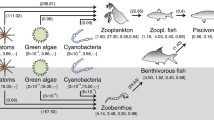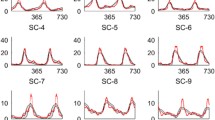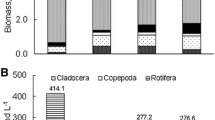Summary
A community model may be considered stable when, in the absence of exogenous variation, all population trajectories encircle or asymptotically approach equilibrium. In this paper, community models in which, in the absence of analytical indications of stability, all populations either
-
1.
exhibit trajectories toward equilibrium or
-
2.
possess properties such that departures from equilibrium are inhibited will be defined as resilient. The necessary properties include appropriate sensitivity (i.e., the total derivative, df i /dV j , of the i th species function, f i =dN i /dt, with respect to the j th variable) to exogenous variables.
A real, though simplified, ecological system consisting of Daphnia galeata and its algal food source in an oligotrophic lake appears to be generally resilient in that changes in the exogenous factors nitrate concentration and temperature of the lake water consistently restrain the departure of predicted population densities from equilibrium.
Each population in the community is represented by the Verhulst-Pearl logistic model of population growth augmented to include environmental effects on rate of increase, r; carrying capacity, K; and the effects of predation on population density, N; and therefore the population rate of change, dN/dt.
It is suggested that such community submodels and sensitivity analysis represent logical and appropriate amplifications in the use of mathematical models in the management of populations.
Similar content being viewed by others
References
Bartlett, M. S.: Stochastic population models in ecology and epidemiology. Methuen's monographs on applied probability and statistics. London: Methuen 1960
Birch, L. C.: The intrinsic rate of increase of an insect population. J. Anim. Ecol. 17, 15–26 (1948)
Brylinsky, M.: Steady-state sensitivity analysis of energy flow in a marine ecosystem. In: B. C. Patten, ed., Systems analysis and simulation in ecology, vol. II, p. 81–102. New York: Academic Press 1972
Chu, S. P.: The influence of the mineral composition of the medium on the growth of planktonic algae. Part II. The influence of the concentration of inorganic nitrogen and phosphate phosphorus. J. Ecol. 31, 109–177 (1943)
Cole, L. C.: The population consequences of life history phenomena. Quart. Rev. Biol. 29, 103–137 (1954)
Davis, J. R.: Effects of reduced inorganic phosphate income on Kootenay Lake, British Columbia. Master's special problems paper, Department of Zoology, Washington State University (unpublished, 1973).
Di Toro, D. M., Thomann, R. V., O'Conner, D. J.: A dynamic model of phytoplankton population in the Sacramento-San Joaquin Delta. In: R. F. Gould, ed., Nonequilibrium systems in natural water chemistry. Advances in chemistry series 106, p. 131–180. New York: American Chemical Society 1971
Eppley, R. W., Carlucci, A. F., Holm-Hansen, O., Kiefer, D., McCarthy, J. J., Vernick, E., Williams, P. M.: Phytoplankton growth and composition in shipboard cultures supplied with nitrate, ammonia, or urea as a nitrogen source. Limnol. Ocean. 16, 741–751 (1971)
Fisher, R. A.: Statistical methods for research workers, 11th ed. Edinburgh: Oliver and Boyd 1950
Fredrickson, A. G., Jost, J. L., Tsuchiya, H. M., Hsu, P.: Predator-prey interactions between Malthusian populations. J. theoret. Biol. 38, 487–526 (1973)
Hairston, N. G., Tinkle, D. W., Wilbur, H. M.: Natural selection and the parameters of population growth. J. Wildl. Manage. 34, 681–690 (1970)
Hall, D. J.: An experimental approach to the dynamics of a natural population of Daphnia galeata mendotae. Ecology 45, 94–112 (1964)
Hazelwood, D. H., Parker, R. A.: Population dynamics of some freshwater zooplankton. II. The effect of lag. Ecology 44, 207–211 (1963)
Holling, C. S.: Resilience and stability of ecological systems. In: R. F. Johnston, ed., Annual review of ecology and systematics, vol. 4, p. 1–23. Palo Alto, California: Annual Reviews 1973
Hutchinson, G. E.: Circular causal systems in ecology. Ann. N. Y. Acad. Sci. 50, 221–246 (1948)
Leslie, P. H.: On the use of matrices in certain population mathematics. Biometrika 33, 183–212 (1945)
Leslie, P. H.: Some further notes on the use of matrices in population mathematics. Biometrika 35, 213–245 (1948)
Long, G. E., Duran, P. H., Jeffords, R. O., Weldon, D. N.: An application of the logistic equation to the population dynamics of salt-marsh gastropods. Theor. Pop. Biol. (in press, 1974)
Lotka, A. J.: Undamped oscillations derived from the law of mass action. J. Amer. chem. Soc. 42, 1595–1599 (1920)
Lotka, A. J.: The stability of the normal age distribution. Proc. nat. Acad. Sci. (Wash.) 8, 339–345 (1922)
Lotka, A. J.: Elements of physical biology. Baltimore: Williams and Wilkins 1925
May, R. M.: Stability and complexity in model ecosystems. Monographs in population biology 6. Princeton, New Jersey: Princeton University Press 1973
Parker, R. A.: The influence of photoperiod on reproduction and molting of Daphnia schødleri Sars. Physiol. Zool. 39, 266–279 (1966)
Parker, R. A.: Some problems associated with computer simulations of an ecological system. In: R. W. Hiorns, ed., Mathematical theory of the dynamics of biological populations, p. 269–288. New York: Academic Press 1973
Parker, R. A.: Some consequences of stochasticizing an ecological system model. In: P. van den Driessche, ed., Mathematical problems in biology, Lecture notes in mathematics. Berlin-Heidelberg-New York: Springer 1974 (in press)
Paulik, G. J.: Studies on the possible form of the stock-recruitment curve. Quantitative Science Paper No. 11. Seattle, Washington: University of Washington 1970
Pearl, R., Reed, L. J.: On the rate of growth of the population of the United States since 1790 and its mathematical representation. Proc. nat. Acad. Sci. (Wash.) 6, 275–288 (1920)
Pearl, R., Reed, L. J.: A further note on the mathematical theory of population growth. Proc. nat. Acad. Sci. (Wash.) 8, 365–368 (1922)
Quirk, J. P., Ruppert, R.: Quantitative economics and the stability of equilibrium. Rev. Econ. Studies 32, 311–326 (1965)
Smith, F. E.: Quantitative aspects of population growth. In: E. J. Boell, ed., Dynamics of the growth process, p. 277–294. Cambridge: Princeton University Press 1954
Steele, J. H.: Notes on some theoretical problems in production ecology. In: C. R. Goldman, ed., Primary productivity in aquatic environments. Mem. Ist. Ital., Idrobiol., 18 Suppl. Berkeley: University of California Press 1965
Sumner, R.: The transformation of energy by Daphnia pulex. Ecol. Monogr. 28, 273–291 (1958)
Taylor, K. G.: Some factors influencing zooplankton populations in Kootenay Lake, British Columbia, Canada. Department of Zoology, Washington State University, M.S. Thesis (1968)
Vandermeer, J. H.: The community matrix and the number of species in a community. Amer Nat. 104, 73–83 (1970)
Verhulst, P. F.: Notice sur la loi que la population suit dans son accroissement. Corr. Math. Phys. Paris: A. Quetelet 1839
Volterra, V.: Variazioni e fluttuazioni del numero d'individui in specie animali conviventi. Mem. R. Accad. Naz. Lincei, Ser. VI, 2 (1926)
Wellington, W. G.: Qualitative changes in natural populations during changes in abundance. Canad. J. Zool. 38, 289–314 (1960)
Whitton, B. A.: Interactions with other organisms. In: N. G. Can, B. A. Whitton, eds., Biology of blue-green algae. Berkeley: University of California Press 1973
Zyblut, E. R.: Long-term changes in the limnology and macrozooplankton of a large British Columbia lake. J. Fish. Res. Bd. Can. 27, 1239–1250 (1970)
Author information
Authors and Affiliations
Additional information
This study was supported in part by the Washington State University Environmental Research Center and by EPA Grant R-800430.
Rights and permissions
About this article
Cite this article
Long, G.E. Model stability, resilience, and management of an aquatic community. Oecologia 17, 65–85 (1974). https://doi.org/10.1007/BF00345096
Received:
Issue Date:
DOI: https://doi.org/10.1007/BF00345096




